The Greatest Driver of the Century - The Poll Votes
Authors
- Mattijs Diepraam, Felix Muelas, Leif Snellman
Date
- January 18, 2000
Related articles
We somehow guessed who number one was going to be. But we didn't expect this close a battle for the other top spots. After finishing up on the impressive gaggle of votes we even got a tie for second place, making this quite an exciting race to the end. A few trends here: the 8W audience generally voted in favour of accomplishment ahead of promise, while also appreciating continued genius above flashes of brilliance. In that respect it would indeed be harder to reward the pre-Nuvolari, pre-Rosemeyer dare-devils since it is hard to truly measure their accomplishments against their successors, as their significant victories were much smaller in number - although usually bigger in margin. But then numbers are remembered, while the margin of victory is often forgotten... Anyway, thank you for taking part and turning this into an interesting exercise for us. So here's how the poll went:
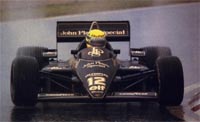 |
1. Ayrton SennaHis amazing record of 65 pole positions says it all: until Imola 1994, Ayrton Senna was a bullet on four wheels. He may have met his match in heaven, for the driver that will eventually surpass his sublime pole record is probably not even born. Senna was a man whose ambition wound him up to intense pressure which then erupted into mind-blowing pole laps and crushing race wins. By no means a single-lap wonder, his unshaken faith was responsible for keeping him in a state of trance for as long as was needed. There were lapses, though, his infamous Monaco slip-up the most notable example, but these were just a few human cracks in a career aiming for immortality. The sure knowledge of divine providence made Ayrton into an arrogant and serious man, who could only accept a joke if it came from Gerhard Berger. His belief to be infallable sprouted some questionable moves on his opponents - it showed a religious self-confidence Michael Schumacher later adopted in his own agnostic way. (md) |
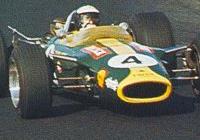 |
2. Jim ClarkSimply the fastest man of his era, Jim Clark gelled with his mentor Colin Chapman enormously. Together they formed an invincible pairing, that is when Chapman's innovative but often fragile designs succeeded in seeing the end of the race - which they didn't in 1964. If they did, no-one touched them. It would have been interesting to have seen Clark race for another constructor but there simply was no need for a switch. In the dominant Lotus 49, he had got off to the best possible start to a campaign undoubtedly leading to a third title when his passion for racing caught up with him. Just as Stirling Moss, Jim drove all sorts of cars in between Grands Prix, just for fun. But at a Hockenheim F2 event in 1968 death played a fatal overtaking game. (md) |
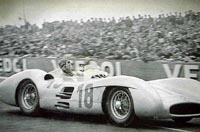 |
2. Juan Manuel FangioStill the man with those for ever invincible records of most wins, poles, points, podiums and fastest laps compared to Championship starts (yes, he has all those and five world championships to boot), there was no stopping the Maestro while he still had a car with four tyres and a steering wheel. If his own wasn't up to it, he just took over his team mate's mid-race and still won. For almost the entire length of his career he had the best equipment to his possession, and rightfully so, for he often obliterated the opposition in bone-crushing style. His tenacity was only truly tested in his final championship year when he took the fading Maserati 250F to title glory. It brought out the very best in him, culminating in that unearthly fightback performance at the 'Ring. This showed his true greatness for he was up against a new wave of fast British drivers and machinery. In a car reaching the end of its life cycle he still beat them. (md) |
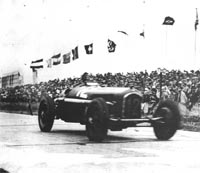 |
4. Tazio NuvolariIf there ever was a man that lived for the sport then it was Nuvolari. Never counting the odds he took on anything, suprisingly often ending up victorious. Neither broken ribs, legs in plaster or inferiour equipment could hinder him from taking the cars into the spectacular controlled four-wheel slides that became his mark.Indeed, the Flying Mantuan breathed racing - literally. In the end, he didn't die in the harnass but his withering away had everything to do with the racing spirit residing in his blood, his body finally losing the fight against years of exhaust pollution. He could have got himself killed on many occasions, though, as he often exceeded the limit to discover its whereabouts. However, on a multitude of those occasions he kept it on the road and won. And in what way! When the Great Little Man became excited he couldn't sit still in his seat but was jumping up and down with his head close to the steering wheel and his arms constantly working. At the high moment of his career Tazio and his Alfa Romeo rattled out win after win after win. But it was only after the German Mercedes and Auto Union onslaught had started its quest for world domination that his unbelievable skills became ever more apparent. It was in that most remarkable of races that Nuvolari took his obsolete Alfa Tipo B to battle on Silberpfeil home soil and outlasted the Führer's favourites to win in a way only Stirling Moss managed to emulate in the 1958 Argentine GP. It has rightly been considered as the greatest race performance ever. The final result of the 1935 German GP took some believing, not in the least for the partizan crowd who saw their state-of-the-art Grand Prix machines beaten by the cunning of a yellow-dressed man sporting a tortoise as his mascotte. This time the hare indeed lost. After the war with his sons succumbed to illness and with few friends left Nuvolari, himself seriously ill, raced like a man possessed, possibly seeking the end on the track. If so, then the reflexes proved to be faster than the mind. Nuvolari's fate was to die in his bed. (md/ls) |
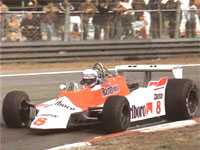 |
5. Alain ProstThat stylish, polished driving style can't be from anywhere else but la douce France. Prost soothed and eased his car to numerous poles and even more race wins - more than anyone else will be able to score for some time to come, in fact. In his final championship year Alain never even looked fast, but when he crossed the finish line the clocks never lied. Emotionally fragile in his early years with Renault, he matured under the care of Ron Dennis and Niki Lauda, taking a leaf out of the Lauda title campaign manual for the remainder of his career. Before that he was the young charger whose championship efforts were thwarted by Renault's ever-present reliability problem (despite all the soothing and easing Prost could throw at the turbo beasts). After stamping out Alboreto's Ferrari challenge in 1985 he became Le Professeur, one of F1's wise men who could nurse and coax a car home no matter what. That he still got to beat Senna on speed on many occasion (outracing the great Brazilian with 41 fastest laps - another Championship record - against Senna's 19) speaks volumes for his unquenchable natural resources. (md) |
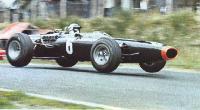 |
6. Jackie StewartThe man valiantly campaigning for track safety was at his best (and bravest) at the tracks he so desperately wanted to change. His Spa and Nürburgring performances were of Rosemeyer calibre, although Spa nearly took his life before he had the chance to win three world championships. A complete driver, the Scotsman used his natural speed to outpace all other March 701 runners in a stop-gap season which didn't prevent him from winning races in an average car. In a similar approach to Alain Prost's taking of the 1986 crown, maturity and calm (and a Lotus team allowing its drivers to take points away from each other) brought Jackie his final glory in a wretched season marred by incident and death. When his friend and team mate Cevert was killed at the Glen JYS had the wisdom to step away right there and then and not complete his century of GPs, just for the sake of it. (md) |
 |
7. Stirling MossWith Chris Amon, he holds the unenviable honour of often being called "the best driver never to have won a...". In total, Stirling Moss finished runner-up in the World Championship four times on the trot, but that is far from reflecting the unparalleled car control which guided him to victory in the largest variety of GP machines and sportscars you could ever imagine. He was good in all of them. Of course, as long as Fangio was around, he was only deserving of second place but after the Maestro withdrew, the world should have been his. As it was, he was never in the best car after that, courtesy of sticking to his word. He secured himself (and Rob Walker, the ultimate of privateers) a place in history with giant-killing performances like the ones in the 1958 Argentine GP and the 1960 Monaco GP, but not even Stirling could perform miracles each Grand Prix weekend against rivals equipped with well-prepared works Coopers and Ferraris. He should have won the 1958 title, though, but his sportsmanship caused him to give up on that hope. It turned him into a national hero as Moss is invariably picked over Clark or Mansell as the greatest British ambassador to the sport. (md) |
 |
8. Alberto AscariContemporary to the great Fangio there are signs that Ascari possibly was the faster driver of the two. Comparisons are very hard however, as they surprisingly rarely faced each other in competitive equipment. Son of his father, Alberto Ascari made a repeat performance of Antonio's dominance in the 1920s for the 1950s fans. Just as his father he was heavily built and muscular. To the fans he became known as Ciccio (Butch). And like his father Alberto he preferred to grab an early lead to control the race from the front. Tutored by Luigi Villoresi his racing career was interrupted by the second World War even before it had properly begun. After the war his career, however, soon gathered speed. From 1949 onwards Ascari raced for Ferrari, dominating the 1952 and 1953 seasons like no one before or since. The decision to join Lancia was controversial as it took a year for the cars to be raceworthy. Ascari was just returning to winning circles when he was lost in an accident that to this day remains a mystery. It's hard to believe but Ascari is the last Italian to become Formula 1 World Champion. (ls) |
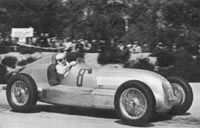 |
9. Rudolf CaracciolaOften believed to be an Italian this German driver became famous overnight when he in 1926 as a privateer won the first German Grand Prix, raced in horrendous conditions. To the Germans he became the Regenmeister and his smooth driving and ability to shine in rainy conditions would be his mark throughout his career. He had reached the top of the GP elite when his career was interrupted by a crash in Monaco 1933, which left him limping with leg wounds that never were properly healed. Suffering from constant pain Caracciola made a comeback to force himself back to a position as head driver for Mercedes, clinching three of the five pre-war championships. By the late 30s Caracciola had lost some of his edge and he had to work hard to beat a new generation of GP drivers. One of Caracciola's triumph cards then was the uniquely good relationship between him and the Mercedes team manager Neubauer, comparable to the Clark-Chapman dominance in the 60s. (ls) |
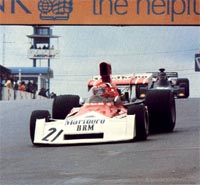 |
10. Niki LaudaNo driver has stirred the interest in Formula 1 racing among the general public as Niki Lauda did. He was selected ISK's Sportsman of the Year in 1977, the only other driver to make the list being Jackie Stewart. After becoming World Champion in 1975 Lauda made his world-famous comeback after his near fatal Nürburgring crash, arising like a phoenix from the ashes, even more determined and clever to take two more championships. Possibly the best car developer ever, Lauda pulled three teams up to the very top. After giving Ferrari a hat trick of constructors championships he went on to build the foundation of Brabham's successes in the early 80s before retiring. He then made a comeback to show McLaren International its way for the future and beat Prost in equal equipment to take the 1984 title. (ls) |
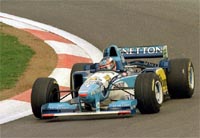 |
11. Michael SchumacherThis confident young German took to the nineties refuelling sprints format as a duck takes to water. Regarded by many - even his staunchest critics - as the fastest man since Senna died, he scored too few pole positions to underline the fact. Instead, he should be seen as the fastest racer since Nuvolari, for on Sundays he is invariably at his best. Paired with the brilliant tactical mind of Ross Brawn (who is to Schumacher what Chapman was to Clark) Michael scored many unlikely wins because of superior pit-stop strategy. Healthier than his opponents, he is able to rattle out middle-stint laps at qualifying speed: give him one more season and he will surpass Prost's record of most fastest laps. It's this showcase of utter fitness and constant ability that demoralizes his adversaries. But Schumacher isn't the perfect driver yet. As a family man and erstwhile Mercedes Junior driver carefully routed to the top he doesn't know pressure. He is without equal when on his own, making up time on the road. However, he crumbles when someone of lesser talent has the audacity to question his authority by virtue of a better car. Vindictive and elephant-brained as Senna was, Schumacher has a sense of honour, though. After his 1995 title he said he was more interested in records than titles - we didn't quite notice that in '97 and '98 - but it's a fact that if he keeps up his win ratio until his Ferrari contract expires at the end of 2001, he will beat the best in half a century of F1 (except maybe for Fangio) in almost every imaginable statistic. (md) |
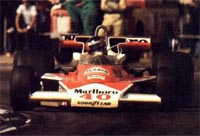 |
12. Gilles VilleneuveIn adversary conditions, he could be on another planet. The take-no-prisoners duel with René Arnoux at Dijon, holding up a train of cars at Jarama in 1981 - these are the textbook examples of Gilles' bravery. But there are other even more remarkable performances that went unnoticed save by a few - like the ten-second gap he pulled in a monsooned first qualifying session at Watkins Glen in 1979. To some, that wasn't a surprise: after Jody Scheckter had taken the crown at Monza, Gilles looked like a man unleashed. In fact, Villeneuve's career theme was waiting for it to be his turn. In 1978, he burst onto the scene and took convincing wins in a year dominated by the magical Lotus 79. In 1979, he invariably held station behind designated team leader Scheckter. In 1980, the car plainly wasn't up to it while in 1981 it was a "tractor". It didn't stop him from winning in it. And then, just when he thought it was his turn, it was taken away from him. (md) |
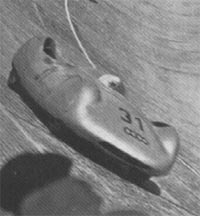 |
13. Bernd RosemeyerIn sheer natural speed and car control, was he the best ever? The only car Rosemeyer ever raced was the monstrous rear-engined Auto Union, a car that even Nuvolari found hard to master. Yet, in a meteoric career Rosemeyer established himself as the world's fastest driver and Germany's most popular GP driver ever. Starting in 1935 he was challenging for the lead in only his second race. In 1936, in his first full season, he clinched the European Championship and forced the mighty Mercedes to retire from racing in the middle of the season. On the infamous Nürburgring track, the ultimate challenge for any driver, Rosemeyer's abilities came to his own. He held the lead every single time he raced there and he finished 2nd, 4th, 1st, 1st, 1st and 3rd. No one (with the possible exception of Gilles Villeneuve) has been able to fully copy Rosemeyer's driving style. In total disregard for the laws of physics the thrill seeking driver, whose favourite number was "13", threw the heavy car around in impossible angles. While he made the occasional mistake, his 10 victories during a time of just two years show his class. Sadly his career was cut short by a 400 km/h crash during a world speed record attempt in early 1938. (ls) |
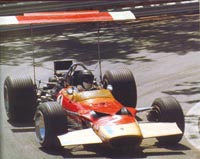 |
14. Jochen RindtWhen Jochen Rindt got killed at Monza in 1970 his replacement was a young Emerson Fittipaldi. Still, his natural successor at Lotus drove a private March 701 that same event and exuded the same style fans came to miss from Jochen. F1's only posthumous World Champion, he would have been a multiple title holder if it hadn't been for that ill-advised practice run, Jochen's Lotus flying off at the Parabolica when its high-speed configuration sans rear wing seemed to prove even too much for Rindt to handle. Then again, things tended to break on the flimsy machines Chapman used to call Lotuses, and he was certainly one to take risks in safety and reliability in order to gain more speed. It was a time when F1 was going through another one of its revolutionary transitions, the wingless cigar-shaped cars of the late sixties transforming into inverted aeroplanes carrying sidepods and slick tyres and sporting airboxes and bulging rear wheels. The era was bound to claim its victims and it was a shame one of them had to be Rindt. As history stands now, the early seventies were the playing field of Stewart and Fittipaldi. No one will take anything away from their titles, but Jochen would have been their nemesis. (md) |
 |
15. Graham HillDedication, determination and will were the main characteristics of this epitomy of the old-fashioned racing driver. Leisurely and uncluttered by pretence when outside the cockpit, keen and gritty when occupying it, Graham Hill had friends all through the paddock - mostly among the guys with the greasy hands and dirty nails. His image suffering from the same syndrome his son Damon was plagued by, his skills are often underrated but for all the supposed lack of natural talent he still worked his way to five Monaco wins, the Triple Crown and two World Championships. And it could have been three had Lorenzo Bandini not punted him off in Mexico in 1964. Perhaps he went on too long after his speed wore off, especially after his horrid accident at the Glen, ultimately becoming an embarrassing midfield contender in such assorted machinery as an ageing Walker Lotus or that private Embassy Shadow. It's just that he so enjoyed to be racing. The ultimate GP veteran of his day, he then set off on that ill-fated effort to field his own team. Having discovered Tony Brise and working closely with Lola, things looked on the up when Hill and Brise started off a sad tradition of racing drivers getting killed in aeroplane crashes. (md) |
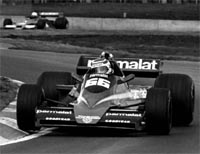 |
16. Nelson PiquetPiquet looked like he was racing just for pleasure, but his incredible natural talent brought him 23 GP victories. While the opposition occasionally could be faster, Piquet was usually the one that would come up on top at the end of the season, whether his opponent was Reutemann, Prost or Mansell. Always seeking to get the technical advantage Piquet and Brabham design wizard Gordon Murray became the perfect duo and amidst flexible skirts, hydraulic suspension, water ballasts, turbo engines and mid-race refuelling Piquet came out as double world champion. At Williams he held a psychological edge over Mansell to take his third title. But Senna was a rival Piquet was never able to outsmart, and the fact that the former took over as most popular Brazilian driver was something Piquet never forgave or forgot. Piquet's eagerness to sign for Lotus, forcing Senna to McLaren, backfired completely and Nelson spent two lacklustre seasons at Lotus. A serious crash at Imola in 1987 possibly had its part in the lost speed but with three victories for Benetton, Piquet showed that the natural talent was still there. (ls) |
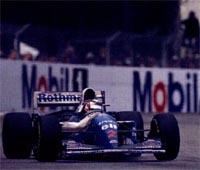 |
17. Nigel MansellIl Leone has 31 Grand Prix victories to his credit and yet no-one will allow him in the same Hall of Fame as his contemporaries. Never a favourite with the press, this folk hero toughened out five barren years with Lotus - where, it has to be said, he was eclipsed by De Angelis - to suddenly find himself in the hot seat Derek Warwick foolishly rejected. At Williams he took on team mate Rosberg's aggressive style and stayed with the team when the Finn was replaced by Nelson Piquet. His poor pre-F1 pedigree gave Our Nige a workman-like image but just as Nelson he had that unquestionable talent of making the most out of the grid's best car, although he was in the slums during 1991, when Riccardo Patrese stole his limelight. Nigel's plucky debut Ferrari drive was the outstanding performance of his career, maybe better than his patriotic win over Piquet in the 1986 British GP. In the end, it was sheer bad luck that prevented him from becoming a multiple champion, which no doubt would have magnified his stature. (md) |
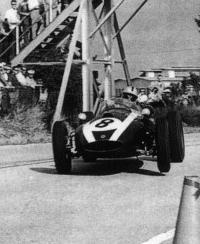 |
18. Jack BrabhamHis three world championships are perhaps overvaluating his ability as a driver but they are a deserving reflection of his accomplishments as a technical innovator to the sport. The man with a vision, he guided John Cooper to the rear-engined revolution that was to change the face of F1. In the event he took Britain to the leading role in motor sports it hasn't lost since. The Australian put his innovative works Cooper to good effect to take two consecutive crowns before setting up his own outfit. As a testimony to his vital role in the team, the Cooper team slowly sank into oblivion after he left, while his own team ran to another two back-to-back titles in 1966 and '67. The way in which they were gained says all about Brabham's approach to the sport: not the fastest car around but by far the most reliable, the Brabham-Repco of the early 3-litre era took advantage of its rival teams' mismanagement (Ferrari) and bad luck (Lotus) to pull out an invincible lead. It was enough for even a solid contender such as Denny Hulme to beat the opposition. At the end of his sixteen-year F1 career Black Jack was still at the top of his game, taking his own car to a final victory at Kyalami. He may have had lost speed over the decade, his experience and cunning made up for it until the very last minute. (md) |
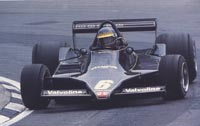 |
19. Ronnie PetersonGilles Villeneuve's predecessor, Ronnie Peterson had all the treats for which tifosi came to love Gilles. Ronnie was by far the fastest driver of his day, he was spectacular to watch and drove with all his heart, and just as is the case with Gilles Ronnie's record doesn't speak volumes about his ability, which was undoubtedly greater than his comtemporary and sometime team mate, double World Champion Emerson Fittipaldi. Both Gilles and Ronnie also did not live to retire peacefully - it just wasn't their style. But Peterson's early demise was perhaps even more tragic than Villeneuve's, as there was nothing heroic about getting killed in a chaotic Monza startline fracas at the end of 1978. Still, if Ronnie had to go prematurely, it had to be at Monza, the scene of his best victories. In 1973, he angered his team mate to take a controversial Italian GP win but he wasn't disobeying team orders - as with Gilles, that just wasn't his style. The events of 1978, where Ronnie doggedly trailed team leader Andretti more than once (Zandvoort the most prominent example) are testimony to that. The 1976 Italian GP perhaps saw his best performance ever, as he took the sorry 761 at the scruff of its neck to give the March team its only full-distance GP victory. Peterson's career planning may have left something to desire, doing the unimaginable in under-par material fulfilled every fan's needs. (md) |
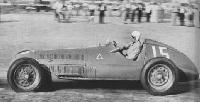 |
20. Achille VarziChilly, unsmiling and clinical, Varzi was one of the greatest drivers of the early 30s but his fate was to be the losing part in the never ending duel with his arch rival Nuvolari, a fight more fierce than the Prost-Senna duel ever. A conclusion of Varzi's driving style can be drawn from the fact that while Nuvolari's career was filled with broken cars and bones in plaster, Varzi crashed only twice in his career. But his second crash would prove fatal. Racing for Alfa Romeo Varzi's best season was in 1934, ending up as top GP driver with twice as much prize money as the best Germans. Moving on to drive the rear-engined Auto Unions, Varzi's career would make a tragic turn. He became a victim of top-level politics and team orders and tried to find an escape in women and drugs. Varzi did not make a comeback until 1946. After two successful seasons the story ended on a rain-soaked Bremgarten circuit. (ls) |
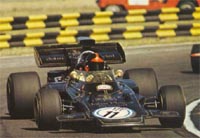 |
21. Emerson FittipaldiThe youngest World Champion in the history of F1 remained a top-line driver for another two decades to come. While Graham Hill is still the only driver to take the Triple Crown (F1 World Championship, the Indy 500 and Le Mans), Emmo's achievement is in the same league as Mario Andretti's: instead of Le Mans he took the full Indycar title as well. The way Emerson burst onto the scene after Rindt's demise will be hard to emulate for any young driver. In that famous first post-Rindt race at Watkins Glen, when Fittipaldi took third on the grid, people were asking themselves "Who is this guy?". The next day he won the race. Never considered the fastest man around, the Brazilian used his intelligence and cunning to come out on top when the chequered fell. It's why he was born for Indy racing. Fittipaldi adapted quickly to oval racing and caution periods to take many strategic wins, including the Big One. His years with his brother's Copersucar outfit may have made him look average at times, but he still did some unusual stuff in cars that were usually very bad: taking second in his 1978 home race his most remarkable patriotic accomplishment. (md) |
 |
22. Mario AndrettiVersatility and experience are words you would associate with Mario Andretti. Having emigrated from Italy to USA at a young age, Andretti became one of the few drivers ever to be a top name in both America and Europe, competing successfully at the top level for 30 years in almost every branch of motor racing. A Le Mans victory was the only thing that he was denied. His versatility is shown in his ability to jump into a unknown car and take pole position as at Watkins Glen 1968 and Monza 1982. His greatest triumph was when he used all his technical know-how to sort out the mess at Lotus and bring them back to the winning circle. In 1977 he already held the technical advantage but missed the championship due to engine troubles, but in 1978 he dominated the season. Here he had the fortune to have a 100% backup by Colin Chapman and a team mate who understood the fact that the Lotus 79 was Andretti's "baby". The mixed emotions of taking the championship after Peterson's fatal crash seems to have taken away the edge from Andretti's interest in Formula 1 and he never proved to be victorious again. However 12 GP plus 52 Indycar wins show the class. (ls) |
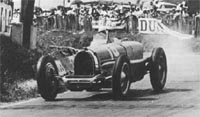 |
23. Jean-Pierre WimilleA man who should have peaked in the early forties saw his quest for ultimate glory evaporate when World War II broke out. Still, when peace returned to Europe and racing cars were wheeled out of their refuges, Wimille was the man to beat. His career ended in tragedy before the F1 World Championship got underway. If he had lived to see the day, he would well have been the driver to have taken Alfa's first world crown. Just as we were robbed of the duel between Senna and Schumacher, the world missed out on Wimille taking on Fangio. What a sight that would have been. (md) |
 |
24. John SurteesPerhaps the man to win world championships on both two and four wheels should have the honour of being the best racing driver of the century. 'Big John' was immediately fast on and in everything. A multiple bike champion, he finished second in his second GP on four wheels. At Oporto, in only his third GP, he took pole and led comfortably for Lotus, only to find a holed radiator on his way. Detesting politics, he was confronted with them on various occasions in his career. It probably cost him a World Championship or two. And it wasn't just the Old Man playing tricks. John had to contend with Colin Chapman's contract wranglings as well. He didn't care to fight for his Lotus seat, instead electing to bail out of the top team for two years with Reg Parnell. In 1966 he was well on his way to a second title when a feud with Ferrari team manager Eugenio Dragoni caused him to leave mid-season. Ironically, the title he did take left a bad taste because of his team mate's "help". But that is nothing to take away from Big John. Speaking volumes for his ability are his striking wins at the old 'Ring. He also brought the languishing Cooper outfit its last win, which was also its first in four years. He then moved on to constructing his own cars and was part of the F1 scene until well into the seventies. (md) |
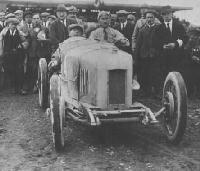 |
25. Felice NazzaroHis career spanning almost three decades, Felice Nazzaro won all three major events of 1907 while as late as 1922 he came back with a vintage Nazzaro win at the French GP. The same year he and Vincenzo Lancia were given the honour of turning the first sods to start off construction of the brand new Monza track. Often accused of inheriting wins, Nazzaro was in fact a driver to keep his gun powder dry until the fireworks really began. Which was usually near the end of the race when his rivals began to fall by the wayside. In the marathon events of the old days this was definitely the cleverest approach and smart Nazzaro was a master at keeping the equipment happy. The same ploy formed the basis of his final glorious victory at Strasbourg, his Fiat 804-404 the only Italian car to stay in one piece until the finish line. The old fox had a price to pay though: failing rear axles had caused his team mates and rivals Pietro Bordino and Biagio Nazzaro to crash on the last lap. Bordino lived but Felice's nephew was killed on the spot. (md) |
Those who just missed out on the top 25:
Louis Chiron
To the fans he was known as Le Vieux Renard (The Old Fox). It is remarkable that one of the greatest drivers ever would come from the little principality of Monaco. That fact would also forever change the history of Grand Prix racing as Chiron together with Anthony Noghès gave the GP calendar its most glamorous event, the Monaco GP. Chiron's career, spanning over a colossal 35 years, included a multitude of victories comparable only to the great Nuvolari. Known as a "ladies' man" with faultless appearance including light blue racing suit and polka dot neckerchief, Chiron soon became famous as the top Bugatti driver of the late 20s and early 30s. He then turned to Alfa Romeo and continued to show good results, culminating in the famous victory at the 1934 French GP. From then on however his career took a deep dive. He had the bad fortune to join Mercedes at the wrong moment and after a serious crash Chiron retired from GP racing to concentrate on sportscars. After the war Chiron made his comeback, his last victory being at the 1949 French GP, when he brought the Talbot-Lago to a surprise win against the faster opposition. Thereafter Chiron concentrated his efforts to organize and arrange the Monaco GP. (ls)
Stefan Bellof
What if...? Racing fans love to speculate about what drivers could have done if the fate had been more fortunate. And no one gives more reason for speculation as Bellof. It's amazing that a driver with only 4 championship points regularly shows up in the lists of the greatest drivers. But in his short career Bellof's performance on the track was such that he has been regarded as the greatest lost talent ever. His driving style was the most exciting you could find during the 80s, surpassing even Senna's qualifying attempts, and there were shadows of the great Bernd Rosemeyer as Bellof took the Porsche 956 through the old Nürburgring track flat out totally regardless of the danger. After having made a clean sweep in local German events, Bellof became known in an instant as the first driver to win an F2 race in his first attempt. In fact Bellof won his first two F2 races. While waiting for an F1 contract Bellof turned to endurance racing in 1983 and next year he became World Endurance Champion by winning 6 out of 10 races. The same year saw him racing for Tyrrell, in an outclassed car stealing 7 points from the almighty turbos before the team became a victim of one of the "Balestre battles" and had all their points removed. Bellof's greatest moment came at Monaco where he rushed through the field from 20th position to 3rd and was catching both Prost and Senna in the rain with totally inferior equipment when the race was stopped by Jacky Ickx. Most of the 1985 season became a waiting game before the team finally got their Renault turbo engines. Once more Jacky Ickx happened to interfere with Bellof's life. In an endurance race at Spa, Bellof did not hesitate to try to pass the old sports cars master at Eau Rouge of all places. The result proved fatal. (ls)
Georges Boillot
The Don Quixote of pre-Great War drivers, and a winner on his debut in 1912, with a 13-minute margin no less, Georges Boillot fought Mercs like they were windmills. In that most famous of races, the 1914 French GP, Boillot came desperately close to becoming the St. George of motor racing through his brave attempt at slaying the dragon might of Germany on his very own in a well-under-par Peugeot. In the end he was foiled, but at least he had put up a great fight with a performance which beggared belief. At Lyons, on the eve of World War I, he proved himself far greater than winner Lautenschlager. With the prize money, the German built himself a house. Boillot had built a legend instead. (md)
Jacky Ickx
When his F1 career started to wane, his brilliance transformed into versatility and souplesse. The hottest thing in F2 in the late sixties, Jacky cannonballed into F1 Villeneuve-style, with a fantastic first full season for Ferrari, becoming a winner in only his seventh GP. His mastery of the 'Ring, preferably in wet conditions, laid bare his enormous skills and he used these to challenge for the title on many occasions, even though he was with Ferrari at a time the Italians severly lagged behind in innovation. He was to remain F1's nearly man, staying with the Scuderia one season too long before a move to Lotus effectively destroyed his F1 career. Having given up on ultimate F1 glory Ickx successfully transformed into arguably the greatest sportscar driver of the century, taking no fewer than a record seven Le Mans victories. Thus the erstwhile qualifying wonder became the world's best endurance racer. In a worthy autumn of his career, he once more underlined his unsurpassed enduro abilities by conquering the deserts in several striking rally raid performances for Peugeot. (md)
Jacques Villeneuve
People say he is his own man. With giant shoes to fill, Jacques would want that to be true. And in some ways there's no reason to argue. Contrary to his father, Villeneuve Jr had a brat-pack, expensive Swiss boarding school education, living the good life before discovering the abilities that made his dad world-famous. He took a completely different route to F1 than Gilles, traveling halfway around the world to end up at Williams. Furthermore, by his F3 and Atlantic performances you wouldn't have guessed he was to claim the title his father never took. Yet in so many mays he is all that Gilles ever was. Speaking his mind outside of the car, giving it all when inside of it, Jacques' attitude to motor sports is vintage Villeneuve. It is very apparent that his addiction to speed and lack of fear form part of an inherited gene complex, just as his ability to use every inch of the road. It is only after his switch to BAR that the similarities in driving style have surfaced - to our joy the cumbersome Reynard-penned machine and the extra front-tyre groove have brought out the need to go sideways at times. And when he does, usually in qualifying, Jacques attacking a corner is every bit as electrifying as the style of his great father. Going one better than Gilles, the young Villeneuve has proved he has the nerve to finish it off, as his Indy 500, CART and F1 titles testify. (md)
Antonio Ascari
'I'm strict with my kids because I don't want them to like me too much. One day I won't come home.' According to legend, those are words by Antonio Ascari. In fact the lives of Antonio and his son Alberto followed an amazingly similar path. Both were to dominate Grand Prix racing. Both liked to race flat out. Both excelled themselves when they were up leading and controlling the race. And both died in a racing car at the age of 36, leaving a widow and two kids. The major difference was that while Alberto would make Ferrari famous, Antonio's sensational performances would be associated with the Alfa Romeo P2. Victories included the 1924 Italian and 1925 Belgian GPs. But a hub cap that became entangled in a fence at the 1925 French GP cut short the career of a driver who still had so much to give. (ls)
Mika Häkkinen
Boys don't cry but grown men do. The opposite of Michael Schumacher, this Flying Finn cracks under the lack of pressure. But when there are piles of it heaped on his shoulders the Iceman delivers. His meteoric pre-F1 career had all the writings of a future World Champion waiting for a chance to clean up. As it turned out, he had McLaren's poorest spell since the early 80s to contend with before his Adelaide crash seemed to have made it all irrelevant. The arrival of Adrian Newey - for many the true World Champion of the nineties - proved to be a turnaround in Mika's career, which in Mansell style had remained winless for some 90 GPs. Furthermore, the new grooved tyres suited the Finn's instinctive style as he outpsyched team mate Coulthard, whose smooth technique - conversely - has gone to waste in these modern snap-and-catch'em machines. But Mika thrives in them. Now established as a team leader, this press-conference nightmare is intent on proving he doesn't just win in the best car, he can dominate in them. (md)
Nino Farina
Known as the first world champion, Giuseppe Farina's career was split in the middle by the war. Starting off in 1933 Farina soon became a pupil of the great Nuvolari and took over as the top Alfa driver when Nuvolari moved to Auto Union. Farina became Italian Champion in 1937, 1938 and 1939. After the war he raced for Alfa Romeo, Ferrari and as a Maserati privateer. After winning the championship Farina had to face Fangio as a hard-to-beat teammate and later after moving to Ferrari Farina had to see himself beaten by Ascari. Farina's trademark was his special racing style with extended arms and the head held back, a style that became the new norm for the next generation of racers. But the style was deceiving because actually Farina was quite an aggressive driver and he often put himself to the limit and beyond. That also meant that burns, fractures and cuts became a part of Farina's life. Farina hated all kind of publicity. He guarded his private life strongly refusing any journalists or photographers to visit his home after his 1950 championship victory. After retiring in 1955 Farina continued to be involved with cars and racing. But on his way to the 1966 French GP he lost control of his Lotus-Cortina in the Alps with fatal results. (ls)
Raymond Sommer
Son of one of France's pioneer airplane manufacturers, Sommer started racing in the early 30s. Because of his courage and driving style the spectators gave Sommer the nickname Raymond Coeur de Lion. Sommer never gave up, always racing flat out even when all hope of a good position was lost. Sommer is surely Grand Prix racing's greatest individualist, as he refused any major offer for a works drive, preferring to be his own man. Of course that decision showed up in the results, as Sommer often tried the impossible task to challenge the latest works cars with antique equipment. Most of Sommer's greatest successes therefore came in sportscar racing. He was victorious at the French GP in 1936 and won at Le Mans twice. Sommer was also known for his fair play and good sportsmanship. After the war he did not hesitate to head of the highly unpopular campaign to release Dr. Porsche from prison. Sommer was racing as good as ever and his sudden death after a freak accident, racing a 1100cc car in a minor event, came as a shock to the racing world. Shortly before he had been awarded the Légion d'Honneur as France's greatest driver. (ls)
Jean Alesi
The new Michele Alboreto, ex-Ferrarista Jean Alesi just goes on and on. His past few seasons as an erratic midfield contender fresh in our minds, mixing flashes of that past brilliance with utter stupidity, it is hard to overcome such a solid obstacle to pronouncing greatness and go back to the days Jean was the man. The year is 1989 and Alesi is on course for F3000 glory when he gets a call-up to replace that waning ex-Ferrarista Alboreto in the unfavoured Tyrrell team. It all comes together at exactly the right time and place: it's Jean's home GP, the Tyrrell is a car you can fight about, and its driver happens to be on top of the world. His Phoenix fight with Senna was the stuff of miracles, and it allowed Jean to effectively pick the top ride he wished. His Sicilian background made him pick the wrong one. It didn't deter him from invariably shining in the wet, as he gave his best years to an under-par Ferrari team. His cruel luck only added to the heroism the tifosi quickly attributed to him. Countless times he was good for a win, only to see his efforts scuppered by an unwilling Prancing Horse. When he ultimately left Ferrari, we somehow knew Jean's win tally was to remain at one. For the true tifoso, remembering that sight of an ecstatic Alesi on top of Schumacher's Benetton, it is more than enough. (md)
World Champions who didn't feature in the top 35:
Mike Hawthorn
The man who introduced Britain's motor racing industry to the world stage was probably not the very best of that fine crop of young British drivers coming to challenge the Continent's reign over F1. He did show them the way, though. In 1952, in his tiny Cooper-Bristol a young Mike raced the almighty Ferraris to score England's first World Championship podium and emerge as the season's biggest find. He was immediately snapped up by Ferrari. His win for them at the 1953 French GP not only finished Ascari's unbeaten run but was of sheer beauty and perseverance as well, as he fought off Fangio in a thrilling slipstream battle. Switching back and forth between Ferrari, the stumbling British teams and family commitments, Hawthorn lost a couple of seasons before finally committing to the Italian team once more. There he took his and Britain's first drivers' title in a year which should have been Moss's. Although he was taken away from us prematurely in a road accident in January 1959, there is no "what could have been" surrounding Hawthorn's ghost, as he had retired as the reigning World Champion. (md)
Jody Scheckter
The Silverstone pile-up he caused made him into a different driver. Before, he had been recklessly fast. Faster than Stewart, faster than Fittipaldi, faster than Lauda, at least on a par with Peterson. In McLaren's on-and-off third car entry of 1973 he regularly upstaged his experienced team mates with mesmerizing qualifying performances, only to mess up in the race. Then Ken Tyrrell picked him up for 1974. Always a man with an eye for talent, Tyrrell was probably the only one who saw Jody could be a worthy replacement for Jackie Stewart. The South African duly delivered. His next race accident would not happen until Germany 1975, while the results kept coming in. Scheckter's record includes some remarkable factoids: he gave Wolf a sensational debut win and raced the P34 six-wheeler to its only victory. The only man to challenge Niki Lauda in 1977, he was immediately groomed for a Ferrari seat. In his first season for Maranello he took advantage of the best all-round car of the season to claim the title. Outpaced by his mercurial team mate and Alan Jones he used his head to deliver the goods. It was ultimate speed that brought him into F1 but it was experience that brought him his crown. (md)
Alan Jones
There is something to be said about beer-guzzling 'Jonesy' and his embarrassing comeback in the eighties. In fact, his two embarrassing comebacks. The outspoken Australian looked awful in his money-grabbing experiences with Arrows and the Haas Lola team, and people were wondering if indeed Patrick Head should be regarded as the true World Champion of 1980. While it should be granted that Alan Jones was one of those Champions-by-virtue-of-the-best-car-by-far, he still beat Regazzoni hands-down and on occasion proved to be equal to Reutemann. You could also say his driving style and ground effects made for a perfect match, allowing for his disappointing results later on, also during his many years in Australian touring cars. But there is this one giant-killing performance making up for all of this: his 1977 Austrian GP win is among the best of the decade. No ground effects, no best car, huge opposition. And it wasn't a fluke either. At Surtees and later on in his season with Shadow he had shown to be able to take a car into the points from a poor grid position. Do that once, and you're good. Do it ten times, and you're not talking about coincidence anymore. (md)
Keke Rosberg
It's common knowledge Keijo Rosberg won just five Grands Prix and took the 1982 title with just the one win. The season before he managed to score the grand total of zero points, the only champion to do so. So, one of the lesser champions? A lucky winner in an era of transition? Well, Frank Williams indeed took him on as a temporary solution in a stop-gap season. And Keke does have the Villeneuve and Pironi dramas to thank for, added to the terrible reliability problem Alain Prost and John Watson suffered from. But that's the way it is - in a perfect world no driver would suffer accidents or engine blow-ups. The fact of that strangest of seasons is that Rosberg managed to put together the best string of finishes, not putting a foot wrong, to take a deserving title. The team managers he came to work with in his early career all say he was one of the best they ever worked with. And then we have his great wins to take into account: the rain-soaked 1978 International Trophy in a Theodore that was even dangerous to drive with dry-weather settings, or keeping it on the marbles in the 1984 Dallas GP. Most of Keke's best efforts went unnoticed though, as he did the unthinkable in outdated and ill-prepared ATSes, Wolfs and Fittipaldis. (md)
Damon Hill
After quitting the sport, Hill Jr has left a remarkable record. On bare figures alone he would be an all-time top-ten on every punter's list of great drivers. 22 wins, 20 poles, 19 fastest laps, many, many podiums, and a World Championship: how could anyone say he doesn't belong to the top? Well, his numerous silly mistakes didn't particularly add to the silver lining his record deserves. And this year he turned his retirement into a soap opera and made his subsequent "aid to Jordan's defense of third position in the constructor championship" into a mockery. Still, there are many great drives to underline his huge talent: Japan 1996 comes to mind, and most of all Hungary 1997. It's just that he is a fine English bloke with a mediterrean form of motivation. When the car wasn't ideal or circumstance (the pressure he built up inside of him, the way he was treated by team managers, the British press) was working against him, you'd think he wanted to be somewhere else on the weekend. Fired up, he could rise to the occasion in a way which kept even Schumacher and Villeneuve trailing. (md)
Some of our pre-war favourites who didn't quite catch on with you:
Marcel Renault
Brother Louis created them but Marcel made them come alive. The Renault brothers were at the forefront of the first in a well documented series of racing car revolutions with a common theme: showing that light and nimble could beat powerful but heavy. Having said that, Marcel Renault's unlikely Paris-Vienna win in the summer of 1902 had more to do with Marcel's skills than with Louis' hugely underpowered Renault cars. Stacked up against the mighty Panhards - that could boast almost triple the engine size of the little Renault - the most talented of the two racing and engineering brothers took a convincing win. Sadly, a year later he would be at the center of the drama which ended city-to-city racing, as a series of heavy accidents caused the Paris-Madrid event to stop short at Bordeaux, Gabriel declared the winner. Eight people (amongst them Marcel Renault) lost their lives in the young sport's most dramatic days since its inception. As a result of Marcel's death, Louis retired from racing and went on to create an empire that was to dominate the top echelon of motor sports many decades later. (md)
Fernand Gabriel
The final winner in the city-to-city era, Fernand Gabriel reached Bordeaux first when the 1903 Paris-Madrid race was stopped. He had come through the carnage to literally survive that first leg. The unbelievable part of the story was that Gabriel had started 82nd and that he had to handle a Mors with a serious weight problem. Still there was nothing that could stop him as he rose above himself to fly through the entire field, leaving it behind in a trail of blood and dust. Having reached the Gironde town he found his remarkable performance had been good enough to wave a dramatic era goodbye. (md)
Léon Théry
Now a name forgotten by most except the most fanatical GP historians, Théry was one of the top drivers when the century was young. As a thoroughly competent mechanic he was one of the first drivers to have an understanding about the limits of the cars and the need to nursing them home to victory. Known as the "chronometer" he had the combination of speed and reliability that earned him the victory of the Gordon Bennett races in both 1904 and 1905 with a Richard-Brasier, the nearest equivalent to being world champion in those days. Like many drivers since he then tried to build his own racing car, a enterprise that failed completely. Returning to Richard-Brasier both car and driver had passed their peaks when Théry died of tuberculosis in 1909. (ls)
Ferenc Szisz
The name of this Hungarian will always be connected to the first Grand Prix in history. He won it. Driving for Renault, 'François' Szisz and his co-driver Marteau led both days in their AK 90CV to win the 1236km monster event over a 103km track near Le Mans. The Grand Prix de l'ACF was to remain on the calendar until 1967 when it was finally rechristened the French GP but the first one - organized by the most famous of local automobile clubs, the ACO - was to remain the toughest in many ways. The undoubted highlight of Szisz's career, his victory came over such respected rivals such as Nazzaro (second) and Lancia (fifth). After you have done that, what else is there to aim for? (md)
Vincenzo Lancia
He wasn't one of motor racing's best finishers, but he would entertain every bystander by going over the edge and still collecting it. It didn't account for many results, but his popular balls-to-the-wall style gave him numerous fastest laps in events usually won by more nursing drivers. The fact that outside of the car Vincenzo Lancia was a clever mechanic aiming for technical perfection made the driver even more of an enigma. Nothing of the precise engineering skills Lancia used to build his automotive empire on remained when the demon took over at the wheel. Today, Lancia is still an evocative name in the automobile industry, the cars bearing his name on the one hand emulating their godfather's racing reliability but on the other oozing the refinement Lancia was known for outside of the cockpit. (md)
Dario Resta
The man that shouldn't have made a comeback. Born in Livorno or Milan, in 1884 or 1882, who knows, but educated in England, drove Sunbeams in Europe before the War. In 1914 he went to America on business and stayed there driving Peugeots against native American drivers, actually winning the AAA Championship and the Board Track Title. By 1917 his activity was over, and he only raced sporadically. Then he made a comeback with Sunbeam to partner Segrave and Guinness in the 1924 season, but suffered a fatal accident in September whilst attempting to break the World Record in Brooklands. His sweeping successes in America during 1915/16 had all been achieved in cars that were already past their first youth. Yet he was the first man to outsmart the Americans. Viewed in this light, Resta must surely have been an archetypal version of Mario Andretti as the Great All-Rounder of Road, Track, Board and even Dirt: a veritable Man For All Seasons in both the old and the new worlds. (fm)
Pietro Bordino
Bordino started off in 1904 as riding mechanic for Nazzaro, Lancia and de Palma. While racing himself from 1908 onwards his real career started as late as 1921. Probably the finest racing driver of his generation, Bordino always took his car to the absolute maximum whether it would last or not, a style that made him the favourite of the enthusiasts. No one could handle a car at high speed on tricky corners as he could. The 1922 and 1924 French Grand Prix were typical. In both races he took an early lead leaving the rest of the GP elite far behind, only to retire near the finish with a broken car. Forever associated with Fiat, he took their car to its last victory at Monza in 1927. Soon after that Fiat quit the sport. Bordino's end came in the form of a dog crossing the track during pracice for the 1927 Targa Florio. (ls)
Robert Benoist
Benoist will forever be associated with the Delage and the 1927 season. Taking the 1.5-litre car to victory in the French, Spanish, Italian and British GPs he claimed the constructors championship for the French team and the Légion d'Honneur for himself. Having started racing in 1921 Benoist was Delage's works driver in 1925-1927. Thereafter he raced Bugattis but future success came in sports cars rather than in GP racing. Benoist had been a fighter pilot during WW1. Too old for the air force when the next World War started he decided to play a game against even harder odds, a game that ended in the Buchenwald prisoner camp in 1944. (ls)
Henry Segrave
This brave Englishman provided a healthy change in a motorsport world dominated by France, Germany and Italy. The first islander to upset the Continent's favourites since Selwyn Edge took the 1902 Paris-Innsbruck Gordon Bennett race, Sir Henry Segrave became Sunbeam's trump card in a poker game in which the odds were stacked in favour of Alfa Romeo, Mercedes, Peugeot and Bugatti. His biggest win came in the 1923 ACF Grand Prix before he switched to Talbot, another unfancied constructor. As was to be expected from his flamboyant driving style Segrave's days ended prematurely, just as the Nuvolari-Varzi-Campari epoch set in. We will never know how he would have held up against the Alfa clan and the likes of Chiron, Dreyfus and Étancelin but the general idea would no doubt be quite positive. (md)
Giuseppe Campari
Well, every good story must have one of these guys. Of the three Alfa Romeo "musketeers" Nuvolari, Varzi and Campari, Campari got the natural role as the team's Porthos. Weighing in over 100kg, good natured, loving good food and singing for the grand opera, it was difficult to imagine Campari as a Grand Prix driver. Because of his dark suntanned appearance he was known as Il Negher. Considering the fact that he was teamed up with drivers like Ascari and Nuvolari, Campari's racing record, spanning 19 years, is quite impressive. Occasionally he was able to challenge even the best of the best. Mostly known as an Alfa driver, Campari raced a Maserati when he achieved his last victory at the 1933 French Grand Prix. At the end of the 1933 season, Campari decided to retire from racing, concentrating instead on singing operas. His last race was to be the 1933 Monza GP, but the day ended in a series of tragedies, only comparable to Imola 1994, Campari being one of the victims. (ls)
Hermann Lang
Coming from a home of small means, Lang had to fight the opinions of the period that racing drivers were to be "gentlemen". Starting off as a motorcycle driver and then working as a racing mechanic, Lang had both the balance and the technical know-how to make it to the very top when he was offered a drive by Mercedes. Immensely popular by his mechanic friends but less so with his team mates Lang was considered to be a high-speed track expert, winning three times at Tripoli and also winning the fastest race of the era, the Avus 1937 extravaganza. 1939 was Lang's year and he dominated the GP season with 5 major victories. While there is controversy about the final results of the 1939 championship, no one could deny that Lang was at least the moral champion. The war interrupted Lang's career when he was at the very top. After the war success came in sportscars rather in GP racing, Lang taking the Mercedes 300SL to victory at Le Mans 1952. (ls)
Luigi Villoresi
Born in 1909, brother to the very fast Emilio with whom he started racing in 1931, created the Scuderia Ambrosiana with Count Lurani and raced Maseratis privately and also as a team member during the thirties, actually being the driver to win, in May 1940, the last European race of the period, the Targa Fiorio. He returned when racing returned, and again won, this time the Nice GP in April 1946. Friend and mentor of Alberto Ascari, they stayed racing together for the following nine seasons. His outstanding years were 1947-48, and from 1950 they stayed together, driving for Ferrari until the end of 1953, Ascari taking two Worlds Crowns in the process with Villoresi winning many races outside the World Championship. By 1954 they both went to Lancia, where Luigi stayed one more year after the death of Ascari. His final year of racing, 1956 was spent at the hands of Maseratis, his first love and one that was going to last until his death, aged 88, in August 1997. An elegant silver-haired Italian, a fine ambassador for the sport and for Maserati and a faithful and successful driver sometimes surprisingly undervalued. (fm)
A few who had their days of brilliance but didn't make the grade anyway:
José Froilan Gonzalez
One of F1's most unlikely stars, this giant of a driver literally possessed the strength to bully a car around a corner. It wasn't for nothing that people called him the Pampas Bull, for watching his overwhelming posture in action was an unbelievable sight to behold. The first non-Alfa winner in the history of the Championship, the big man should have won the 1951 title, if not for his fellow countryman extracting every last bit of breath from his ageing Alfetta to thwart Gonzalez and his superior 375. If only Froilan had driven that Ferrari at Bremgarten as well... In the Ascari years he played second fiddle in an under-par Maserati and never really latched on to the form he showed in the summer of 1951. On his return to Ferrari he became a threat once more, taking a win and two poles, but there was always that other Argentinian taking the limelight… (md)
Tony Brooks
With Moss this extremely gifted driver shares the honour of taking the first World Championship win by a British constructor. Another one scared away by the dangers of the infant BRM P25, Brooks quickly hooked up with Tony Vandervell to become lead driver for Vanwall. Together with Stirling Moss and Stuart Lewis-Evans, Brooks turned Vanwall into a threat in one season and a championship winner in the next. With Vandervell pulling out after Lewis-Evans' demise, Tony joined the opposition to race to a career-best championship position of second. At an apparent disadvantage to Brabham's rear-engined Cooper, Brooks' pole-to-win achievements in France and Germany were the highlights of the season. (md)
Jean Behra
Nicknamed "Jeannot"and "The Sorcerer", he never won a World Championship Grand Prix but no less than nine races of rank during his operational years 1952-1959, including the 1957 Grand Prix of Casablanca. With France losing its cornerstones - Wimille in 1949, Sommer in 1950, and Chiron and Étancelin's gradual eclipse - Behra abandoned two wheels for four in 1951, at the relatively mature age of 30, to drive for Gordini. His volatile driving and his white helmet, with its distinctive black chequered ring round it were not long in asserting an unmistakeable and welcome touch of Gallic verve. By 1956 he started driving for Maserati, then moved onto BRM and then, quite fatally, to Ferrari just when BRM was about to start winning. His character proved to strong for Tavoni, and they soon departed company. A few days later, on the wet and treacherous banking at Avus, driving a little sports Porsche RSK, Behra was beaten by himself. Forever. (fm)
Dan Gurney
The only driver feared by Clark, this American managed to upset the British establishment in machines which weren't exactly the class of the field. His accomplishments for Porsche should be lauded immensely while his decision to become a constructor may have kept him from seriously challenging for the world championship. A true all-rounder, Gurney also excelled in sportscars and stock cars, adapting his style to the needs of his mount. As a constructor, he has taken his Eagle cars into the same variety of playing fields., his major successes under the All American Racers banner coming in Indycars in the 70s and in IMSA sportscars in the 80s. Together with Gurney the Eagle marque left F1 quietly but it had left a glorious impression. While perhaps the Eagle T1G wasn't the best car around, for many it was certainly the best looking. (md)
Pedro Rodriguez
Sometimes the sun must go down before you can see the moon. While junior brother Ricardo's career was metheoric, Pedro's was merely good and it was not until his last seasons that people really became aware of his true abilities. Encouraged by a rich father the brothers begun their racing careers at a very early age and soon they were to become Mexican national heroes. Naturally Ricardo's fatal crash in 1962 made Pedro's career struggle a bit and it was not until 1967 that he had his first full GP season, having signed on as works driver for Cooper. Pedro immediately took a win at the Kyalami season opener. In 1968 he raced for BRM and after having to leave the team for 1969 he was back again the next year for his last two GP seasons. It was however in sportscar racing that Rodriguez really shone, dominating the 1970-71 seasons with the Porsche 917K. It was also in a sports car he had his fatal accident after a puncture. A small but colourful man (he always carried with him his own pepper and tabasco when he travelled abroad) Pedro really lived for racing and his fearless driving style made him immensely popular among racing fans. (ls)
Carlos Reutemann
Here's a man with the talent to have claimed at least two World Championships. Instead, Carlos Alberto Reutemann ended up with none, suddenly running away from F1 just two races into the 1982 season, when the size of the Las Vegas drama hit him full-force. Quiet, reflecting, and unpopular with his team mates, he could fly when he had his day. Then he was truly the Great Driver of his era. But when push came to shove others took the headlines, aided by better cars, smarter career moves and Carlos' self-destruct button, which didn't need any outside assistance to be activated. In 1981 he finally had the best car to himself and he outraced team mate and reigning champion Jones to battle it out with the equally competitive proposition of Piquet in a Gordon Murray-designed Brabham. We all know what happened. In the Championship's statistics of wins, poles, points, podiums, fastest laps, etc., 'Lole' invariably hits the all-time top-ten, a huge testimony to the opportunities lost. (md)
Tom Pryce
The Stefan Bellof or Chris Bristow of the seventies? It's hard to assess Tom's real abilities as he kept faithful to the Shadow squad for his entire GP career. Which means he never had the opportunity he could handle the pressure of leading a race at the highest level. Nor could he show he had the consistency and calm to put together a Championship effort. But as a racer, Tom was a flyer. And what he managed in Shadow's DN5 and DN8 cars needs defying. Granted, the DN5 was a fine racing car, a fact underlined by "Jumper" Jarier (one of the sport's most underrated drivers) as the Frenchman took back-to-back poles in its first two races. But during the year the unexperienced Brit got the upper hand on Jean-Pierre, eventually leading to a magnificent pole at his home race and some very consistent finishes well into the 1976 season, when the DN5 in B spec began to show some signs of ageing. Still sticking with Shadow for 1977, people longed for his breakthrough which eventually never came. In the freakiest of all fatal F1 accidents, Tom was hit on the head by a fire extinguisher gone havoc after his team mate Renzo Zorzi hit a marshall who was running across the track to come to the aid of a burning car. Tom and the marshall were instantly killed. (md)
Gerhard Berger
Most probably just remember Berger as the light-hearted practical joker and ladies' man of GP racing. If born 15 years earlier, Berger would possibly have been one of the greatest drivers ever. Now most of his career he had to suffer from the handicap a lanky driver has to endure while driving modern GP cars. His career almost ended before it started. Expected to be hospitalized for half a year after a road accident, Berger with sheer determination made a comeback less known but not less impressive than that of fellow countryman Niki Lauda, being back at the wheel two weeks after the crash. His maiden victory in Mexico in 1986 also showed his will to win, as he was racing with high fever. A good technician, Berger's victories typically came at the end of the season when initial problems had been sorted out. A San Marino crash 1989 seemed to have changed Berger and he calmly settled down as Senna's teammate for three seasons. Then followed several seasons with Alesi at Ferrari and Benetton, where Berger got the main responsibility for the development of the cars. The seasons proved frustrating, especially in 1997 when the rules caused Berger's helmet to destroy the aerodynamic flow of the car, but when things were right he still could show his true abilities, as when he completely crushed the opposition at Hockenheim. (ls)
So you refused to look ahead! OK, point taken:
Heinz-Harald Frentzen
When Frentzen came into Formula 1 it was rumoured that he was possibly even faster than Schumacher. After having lived his early career in the shadow of his Mercedes team mates Schumacher and Wendlinger Formula 1 was the place where it was expected that the quiet and good natured German could show his real ability. Initial performance with Sauber was impressive but then came two disastrous seasons with Williams and by 1999 Frentzen's career had reached a critical stage. We now know that the Williams saga was a complete waste of raw talent, because after the move to Jordan Frentzen finally came to his own, dominating over Damon Hill and ending up with two victories. In fact, in a season where neither Ferrari nor McLaren seemed to want or deserve the championship, Frentzen, with his odd chance for the title, suddenly became the favourite for more than one racing fan. Frentzen has now established himself among the GP elite. What he needs now is to be in the right team at the right time to get a chance for the title. (ls)
Ralf Schumacher
One of our picks for the 21st century, Ralf has come good this season. Not that he has ever been bad, but it has been a tough process learning how to bring home the bacon. In fact, it was a process of reinvention since bacon delivery had been one of his major skills during his F3 and F Nippon days. Ralf taking the Japanese title at his first attempt is the positive proof of that. Then came one of Eddie Jordan's poorer decisions when the Irishman put two young hotshoes in his cars. Instead of rubbing of each other, Giancarlo Fisichella and the young Schumacher violently hit heads during the 1997 season, the two reversing national characteristics when Ralf started overcooking it in a very mediterrenean way while Giancarlo showed Teutonic coolness in taking many points finishes. Still, it was plainly apparent that Ralf was the faster of the two, so it came as no surprise that he outpaced Damon Hill when the Englishman joined Jordan for the 1998 season. The maturing that set in when the Jordan began to show some speed and reliability meant a quick end to Ralf's overdriving and then we were reunited with the confident Schumacher we had come to know in F Nippon. In 1999 the pattern continued, Ralf competing with Heinz-Harald Frentzen for best driver of the season honours. (md)
